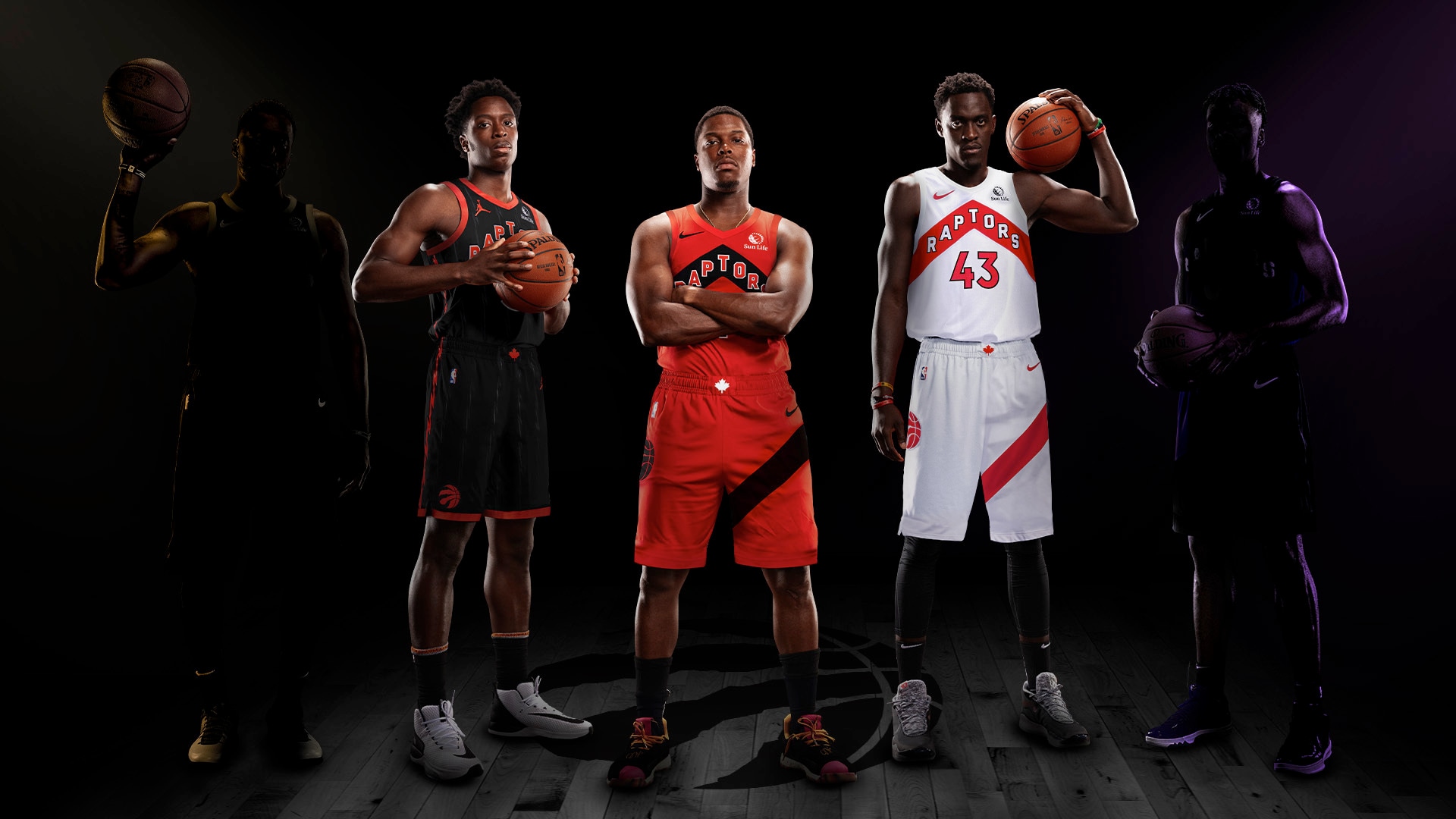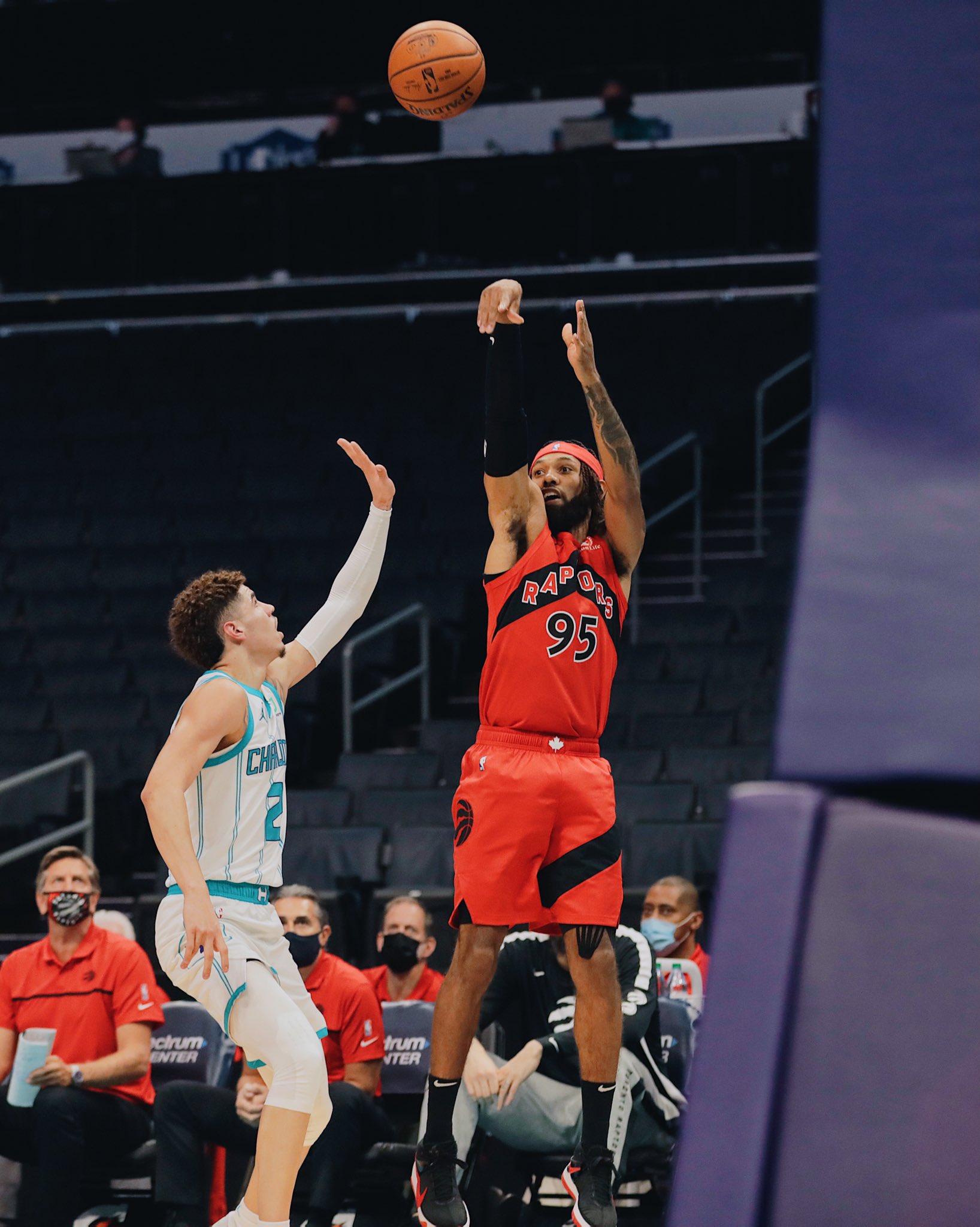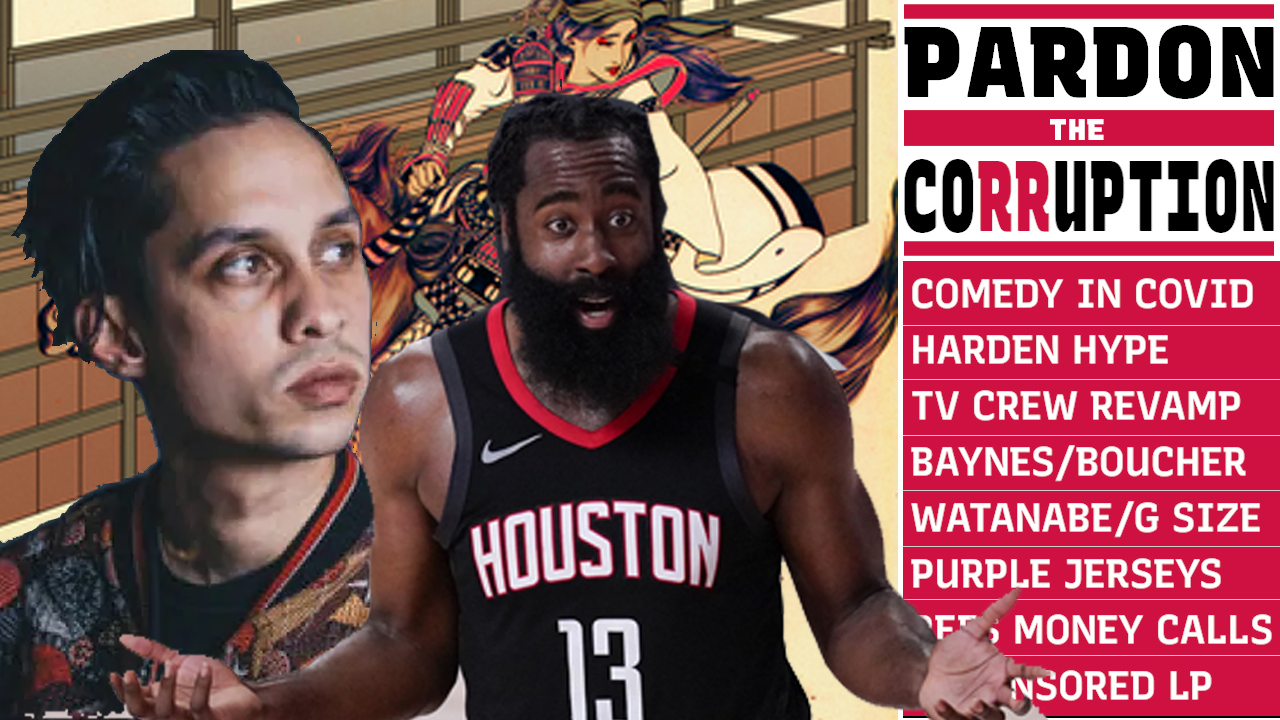Back with my (now) annual most interesting storylines column, this time previewing the 2020-21 Toronto Raptors.
While the disappointment of last season’s loss to the Boston Celtics in the Eastern Conference Semi-Finals was compounded by Giannis Antetokounmpo’s recent extension with the Milwaukee Bucks, the Raptors still have plenty of options at their disposal with respect to building back a championship contender. It’s obvious that they are missing a piece or two, though, so barring a big trade, this season is about seeing what they have in their core of Pascal Siakam, OG Anunoby, and Fred VanVleet: how much of a load each guy can effectively carry, and what exactly they need to put them over the edge.
With that being said, this is still a very competitive team. The Raptors might not be title favourites, but they could overachieve and make a deep run if everything breaks right. It’s just that their margin for error is small.
Plus, there are plenty of questions hovering over the season, including: How much will the losses of Serge Ibaka and Marc Gasol hurt? Has Pascal Siakam plateaued? Can the half-court offense improve? And just how much can rookie Malachi Flynn stabilize the bench in his first year?
Here are the five most interesting storylines heading into the Raptors’ 2020-21 season:
1. Frontcourt depth
My biggest concern heading into the season pertains to the Raptors’ frontcourt. Specifically, do they have enough depth, versatility, and flexibility in their frontcourt to succeed?
The losses of Serge Ibaka and Marc Gasol will hurt for a number of reasons, the main one being that the Raptors never replaced the flexibility and versatility that the big-man duo provided. Both Ibaka and Gasol could play alone, they could play together in mega lineups, they could space the floor, they could facilitate, and they could at least both hold their own on defense. On top of giving the Raptors the versatility to play to their strengths for 48 minutes each night and force opposing teams to match up to them, having both Ibaka and Gasol was a luxury because it meant that Nick Nurse could lean more heavily on whoever was feeling it on any given night. Relying on the “hot hand” is a huge part of Nurse’s coaching philosophy, but it’s hard to do without good depth at every position.
As Yahoo’s William Lou predicted in his “eight bold predictions” column, the only traditional big man on this season’s roster that is likely to see playoff minutes is Aron Baynes (and at 34 years old, I’m not sure he can play more than 20 minutes a night). While Chris Boucher and Alex Len each provide a nice specific skill set, neither has proven to be able to play in high-leverage moments like the playoffs or even at the end of games. That could be a problem.
Maybe Nick Nurse will lean more heavily on his small-ball lineups with Anunoby and Siakam sharing the frontcourt — a group that outscored opponents by 5.7 points per 100 possessions in the playoffs — but small-ball is very matchup-dependent and likely won’t succeed for long stretches against Joel Embiid/Dwight Howard or even Daniel Theis/Tristian Thompson; nor will it be able to successfully “wall-up” against Antetokounmpo and the Bucks. As of right now, the Raptors’ only option is to sacrifice skill for size by playing Boucher or Len while one or two of their best players is left riding the bench.
However, if Boucher or Len can take a step forward and garner Nurse’s trust on both sides of the ball — or if the Raptors can make a trade for another big man before the trade deadline, perhaps using Norman Powell as a trade chip — then the Raptors will be less dependant on small-ball and better able to match up against all of the East’s best teams.
2. The Pascal Siakam question
You may have heard that Pascal Siakam had a rough showing inside the NBA bubble. He certainly heard the chatter. But the reality is the jury is still out on whether or not Siakam can be a No. 1 offensive option on a really good team. You might be ready to give up on him after only one season at the helm of an offense, but given his unique career progression to date, I’m not.
This is likely Siakam’s last chance to prove that he can be that player, though, as he will have a huge offensive load for the second straight season, with the offense likely revolving around him even more than it did last season due to Gasol and Ibaka’s absence. Whether or not Pascal can build on his 55.4 true-shooting percentage on 28.1 percent usage from last season will have big implications in determining how the Raptors’ front office builds the team going forward.
As my colleague Samson Folk pointed out, Siakam is good at almost everything offensively but not elite at any one skill outside of transition-scoring.
So few weaknesses in his game. Basically, Siakam's next step is when he becomes elite in one or more of these categories (transition excluded). This looks like a man on the precipice or plateau, and I'm excited to see which it is. pic.twitter.com/qJdfnDfMZR
— Samson Folk (the coach) (@samfolkk) December 17, 2020
Last season, Nurse and his staff made it really hard on Siakam. He was asked to create a lot of the Raptors offense himself without any screen help, leading him to isolate on 17.6 percent of his possessions and post-up 12.2 percent of the time, allowing him to work as the pick-and-roll ball handler in just 14.2 percent of his possessions (compared to 25.5 percent for Jason Tatum) and even less frequently in the playoffs. However, things could be different this season.
One way to unlock some of Siakam’s offense is by increasing his pick-and-roll reps. We saw a little bit of that already in the preseason, with Baynes screening for Siakam at the top of the key, and it would be nice to add an inverted pick-and-roll with Kyle Lowry or VanVleet screening for him, especially if the Raptors close with those small-ball lineups.
https://twitter.com/robeltussin/status/1339625813784846337
Those types of looks will give Siakam a better path to the basket, especially if defenses respect his shot enough to go over screens. Siakam is an elite finisher at the rim, but one thing he could add to his game this year is the ability to consistently draw contact and get to the free-throw line. Last season, Siakam got to the line 5.1 times per game, which sounds nice and ranked 28th in the league, but it was a relatively small leap from the 3.8 attempts in 2018-19 given that his usage increased by almost 8.0 percentage points. Siakam’s goal for next season should be to get to the free-throw line as much as wings like Brandon Ingram on the low end (5.9) or DeMar DeRozan on the high end (6.6).
Also, if Siakam is going to develop into an effective No. 1 option, he will have to be able to create efficient offense at the end of games when things slow down in the half-court, and getting better at drawing contact can be part of that. Last season, the Raptors shot 48.1 percent in clutch time, which ranked third in the league, but a lot of that was Kyle Lowry and they regressed in the playoffs to just 32.7 percent. If the Raptors perform well in the clutch this season, it’s a good sign that Siakam has taken a step forward as a half-court initiator and a good indication that they can replicate it in the playoffs. But if by the end of the season Siakam is still not comfortable in that role, it could be a problem in the playoffs because as good as Lowry is, he can’t be the team’s primary option.
3. Offensive distribution
Another one of the biggest questions pertains to how the Raptors’ offense will look this season. Now that Gasol is gone, the Raptors won’t have the luxury of playing through one of the best passing big men of all time. Baynes is a solid passer himself, but using him as a primary facilitator could have diminishing returns. Plus, the Raptors hired assistant Chris Finch out of New Orleans to help run their offense, so it will likely look different than last season.
Once again, there are big implications here: Does VanVleet get even more on-ball reps despite his best offensive skill being a catch-and-shoot threat? Does OG Anunoby get more opportunities to develop his shot creation and playmaking skills with the ball in his hands? Or will Lowry and Siakam be the teams’ two primary playmakers?
Chris Finch has talked about adding “unpredictability” to the Raptors’ offense. He mentioned using Siakam and all the attention he receives from defenses to their advantage with more cutting and off-ball movement, something Powell and Anunoby would seem to benefit from as effective cutters. In his past stops, Finch has also prioritized off- off-ball screens to free up shooters, which is something the Raptors have lacked around Siakam isolations and post-ups in the past:
Another thing Finch can bring to the offense is a heavier diet of pick-and-rolls. Despite the play-type being a staple of modern NBA offenses, last season’s Raptors were ineffective and infrequent in using the pick-and-roll. Toronto’s ball handlers finished pick-and-rolls just 14.1 percent of the time, the fourth-lowest frequency in the league, scoring close to league average at 0.87 points per possession. Plus, since neither Gasol or Ibaka were strong rim-runners, Toronto’s rollers finished with just 1.02 points per possession, the second-worst mark in the league. In other words, there’s room to improve.
Baynes should help. He scored 1.14 points per possession when finishing as a roll man in 2019-20 (higher than Gasol (0.90) or Ibaka (1.00)) and, more importantly, his screen-setting will help Toronto’s ball-handlers find more room to manuver in the pick-and-roll. Baynes averaged 3.0 screen assists per game last season, more than either Gasol (2.0) or Ibaka (2.4), and you can tell by watching him that he creates a lot more separation with his picks.
Aron Baynes Suns vs Jazz Stats and Highlights
🎵 9 points
🎵 8 rebounds
🎵 6 box outs (game high)
🎵 4 screen assists
🎵 1 three pointer made (69th career)
🎵 0 turnoversFinal Grade: 😈 😈 😈 😈 😈 pic.twitter.com/CP4OpIcGRc
— Unofficial Aron Baynes Fan Club (@BaynesFanClub) February 25, 2020
While Toronto’s transition game and free-flowing half-court offense were a big part of their identity last season, they have the tools to be a more effective pick-and-roll team in 2020-21, even if that makes them a little less fun to watch.
4. Flynnsanity
Most of what I just wrote pertains to the Raptors’ starters — specifically Siakam — but what about the bench? Last season, a bench made up of Powell, Ibaka, Boucher, Matt Thomas, and Terence Davis ranked 14th in offensive rating by being elite in transition but poor in the half-court.
More concerning than their middling offense was that only two of them — Ibaka and Powell — were trusted in the playoffs, forcing Nurse to lean heavily on VanVleet and Lowry, who both tired out by the end of the Celtics’ series. Seven players are simply too few to make a title run, which is likely why Nurse has already talked about wanting to find a dependable eighth-man.
Enter Malachi Flynn, the biggest hope to stabilize the bench and the highest-upside player to possibly get playoff minutes outside of Powell and the starters. Flynn will have to earn every minute he gets, especially considering he is a small rookie in Nurse’s defense-oriented system, but I think he will. After all, Flynn already has playmaking and shot-creation tools that nobody on the bench provides
Flynn comes into the league after winning Most Valuable Player and Defensive Player of the Year in the Mountain West Conference in his senior year at San Diego State. Flynn was one of the best pick-and-roll players in the draft and get to play with proper spacing white running pick-and-roll with big men like Boucher and Len, who last season managed 1.15 and 1.04 points per possession as the roller, respectively, giving the Raptors’ bench a much-needed half-court tool.
Plus, Flynn can flat out score. He puts some pressure on the rim but even more importantly can exploit advantages to buy buckets at all three levels. That is what separates him from VanVleet, who is still searching for a mid-range shot.
My fav Flynn play last night. Don't have to pull up from 3 against a long contest or get all the way to the bucket, just have to find a lil space. Excellent balance. It's a really important shot to have. Would be nice if Fred developed this, too pic.twitter.com/GSp6b6xU6C
— Samson Folk (the coach) (@samfolkk) December 15, 2020
It’s nice that Flynn can create his own looks and provide additional playmaking, but the most important thing is that he is a pure point guard — the only one on the roster besides Lowry — and makes the right reads surprisingly fast. He’s a cerebral player who should help stabilize the bench, and he could become even more important in case Lowry or VanVleet miss time due to injury.
5. Terence Davis II and fans during COVID-19
You might think that these two issues are unrelated, but they’re not: Both of them have to do with morals, doing the right thing, and, as Masai Ujiri likes to say, humanity.
I examined some of the long-term effects of COVID-19 and the risks of having fans at games here (which the Raptors are doing in a limited capacity). And Katie Heindl has done some important writing on the Terence Davis II situation here.
Here’s what I’ll say in relation to both issues: Even if the Raptors have additional information we don’t have regarding the Davis case or the risks of having fans during COVID-19, the optics are extremely bad. And optics important for a franchise that purports to really, actually care about women and racialized people (who are disproportionately affected by COVID-19). You don’t want to be the franchise that loses fans (and money) in the long run by pursuing short-term advantages.
With that being said, I’m willing to give the Raptors the benefit of the doubt for the time being. I admire Ujiri and the way he runs the franchise and I think the Raptors have consistently gotten stuff right since he took over; I’m going to give them the benefit of the doubt that they will handle the Davis case properly once the investigation concludes, and I’m going to give them the benefit of the doubt that having fans in the arena does not increase their risk or the players’ risk of contracting COVID-19.
But for a player as inconsequential to the Raptors’ title hopes as Davis, and for a franchise that has seen its net-worth increase by almost $1 billion over the last few years, I don’t see any reason why Ujiri and Co. should stake their reputation on these relatively small advantages in the short-term when what they have been building in Toronto is worth so much more.
Fans care about these issues, and we aren’t going to just forget about them once the season starts. I hope the Raptors acknowledge that.
Thank you for reading! I am planning on exploring a few of these storylines in more detail in the coming weeks, so if you have any suggestions about which topics I should explore, please let me know in the comments.



